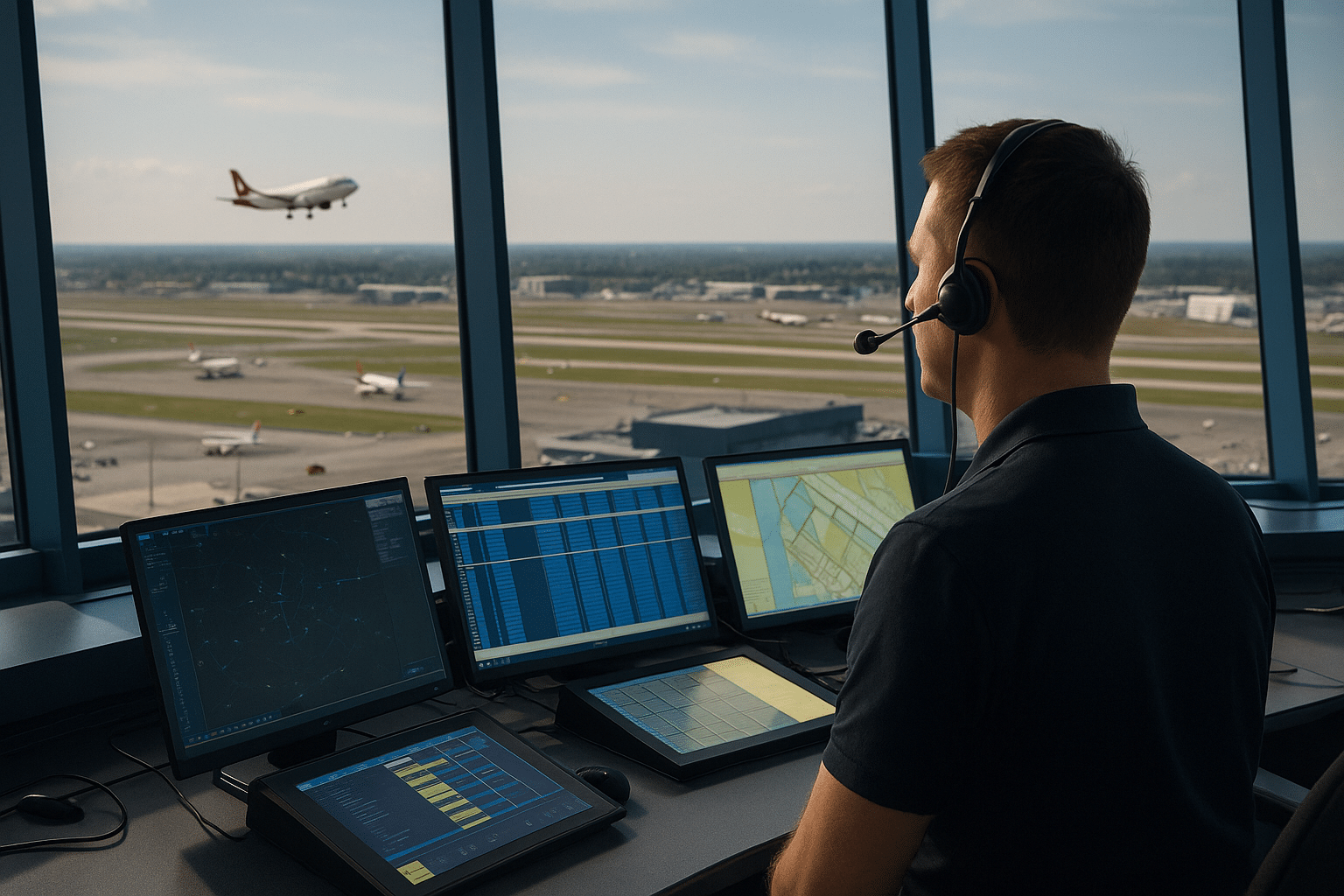The aviation industry is soaring to new heights, and at the heart of this transformation is satellite air traffic control. This cutting-edge technology is redefining how we manage the skies, ensuring safer, more efficient air travel for millions of passengers worldwide. In this article, we’ll dive into what satellite air traffic control is, how it works, its benefits, and why it’s a game-changer for the aviation industry. Whether you’re an aviation enthusiast, a pilot, or simply curious about the future of flight, this guide will break it all down in a conversational, easy-to-understand way.
What Is Satellite Air Traffic Control?
Satellite air traffic control (SATC) is a modern approach to managing air traffic using satellite-based systems instead of traditional ground-based radar. Unlike conventional air traffic control, which relies on radar stations with limited range, SATC uses satellites to track aircraft in real-time, providing global coverage, even over remote areas like oceans and deserts. This technology leverages Automatic Dependent Surveillance-Broadcast (ADS-B), a system where aircraft broadcast their position, altitude, and velocity to satellites, ground stations, and other aircraft.
Imagine a world where air traffic controllers have a crystal-clear view of every plane in the sky, no matter where it is. That’s the power of satellite air traffic control. It’s like giving the aviation industry a high-definition GPS for the skies, making air travel safer and more efficient than ever before.
How Does Satellite Air Traffic Control Work?
At its core, satellite air traffic control relies on a network of satellites equipped with ADS-B receivers. These satellites orbit the Earth, collecting data from aircraft equipped with ADS-B transponders. Here’s a simplified breakdown of how it works:
- Aircraft Broadcast Data: Planes equipped with ADS-B transponders send out signals containing their precise location, speed, and other flight details.
- Satellites Receive Signals: Low Earth Orbit (LEO) satellites, like those operated by companies such as Aireon, pick up these signals, even in areas where ground-based radar can’t reach.
- Data Transmission: The satellite relays this data to air traffic control centers on the ground, providing real-time updates.
- Enhanced Monitoring: Controllers use this data to monitor aircraft, manage air routes, and prevent collisions, all with unprecedented accuracy.
This system allows for continuous global surveillance, closing the gaps in traditional radar coverage. It’s particularly transformative for oceanic and polar routes, where radar coverage is sparse or nonexistent.
Why Satellite Air Traffic Control Matters
The aviation industry faces increasing challenges as air travel demand grows. According to the International Air Transport Association (IATA), global air passenger numbers are projected to reach 8.2 billion annually by 2037. With more planes in the sky, air traffic control systems must evolve to handle the complexity. Satellite air traffic control addresses these challenges by offering:
- Global Coverage: Tracks aircraft over oceans, deserts, and remote regions where radar is unavailable.
- Improved Safety: Real-time data reduces the risk of mid-air collisions and enhances situational awareness.
- Increased Efficiency: Optimized flight paths save fuel, reduce emissions, and shorten travel times.
- Cost Savings: Airlines benefit from reduced fuel consumption and more direct routes.
These benefits make SATC a cornerstone of modern aviation, aligning with the industry’s push for sustainability and safety.
The Role of ADS-B in Satellite Air Traffic Control
Automatic Dependent Surveillance-Broadcast (ADS-B) is the backbone of satellite air traffic control. This technology allows aircraft to determine their position via GPS and broadcast it to satellites and other receivers. Unlike radar, which requires line-of-sight, ADS-B provides precise, real-time data, enabling controllers to track planes with pinpoint accuracy.
Key Features of ADS-B
- Accuracy: Provides location data within a few meters, compared to radar’s kilometer-wide margins.
- Frequency: Updates every second, offering near-instantaneous tracking.
- Interoperability: Works seamlessly with ground-based and satellite-based systems.
By 2020, the Federal Aviation Administration (FAA) mandated ADS-B Out for most aircraft operating in U.S. airspace, a move mirrored by other countries. This global adoption has paved the way for satellite air traffic control to become the standard.
Benefits of Satellite Air Traffic Control for Airlines and Passengers
Satellite air traffic control isn’t just a technical upgrade; it’s a win for airlines, passengers, and the environment. Let’s explore the key advantages:
Enhanced Safety
Safety is the top priority in aviation, and SATC takes it to the next level. With real-time tracking, controllers can detect potential conflicts early and guide aircraft away from danger. For example, over oceanic routes, where radar coverage is limited, SATC ensures continuous monitoring, reducing the risk of accidents.
Fuel Efficiency and Cost Savings
By enabling more direct flight paths, satellite air traffic control cuts down on unnecessary detours. According to Aireon, airlines using SATC can reduce fuel consumption by up to 2% per flight. For a single transatlantic flight, this could mean savings of thousands of dollars in fuel costs annually.
Environmental Impact
Fewer detours mean lower carbon emissions. The aviation industry is under pressure to meet sustainability goals, and SATC helps by optimizing routes and reducing fuel burn. This aligns with global initiatives like the Carbon Offsetting and Reduction Scheme for International Aviation (CORSIA).
Improved Passenger Experience
Shorter flight times and fewer delays translate to a better travel experience. Passengers benefit from smoother operations and more reliable schedules, especially on long-haul flights.
Challenges and Limitations of Satellite Air Traffic Control
While satellite air traffic control is revolutionary, it’s not without challenges. Implementing a global system requires significant investment and coordination among stakeholders. Here are some hurdles:
- High Costs: Equipping aircraft with ADS-B transponders and launching satellites is expensive.
- Regulatory Harmonization: Different countries have varying regulations, complicating global adoption.
- Cybersecurity Risks: Satellite-based systems are vulnerable to hacking and signal interference.
- Infrastructure Gaps: Some regions lack the ground infrastructure to fully integrate SATC.
Despite these challenges, the aviation industry is committed to overcoming them, with organizations like the International Civil Aviation Organization (ICAO) leading efforts to standardize SATC globally.
Information Table: Key Specs of Satellite Air Traffic Control Systems
| Feature | Description |
|---|---|
| Technology | Automatic Dependent Surveillance-Broadcast (ADS-B) |
| Coverage | Global, including oceanic and remote areas |
| Update Frequency | Real-time (every 1–2 seconds) |
| Accuracy | Position accuracy within 10 meters |
| Key Players | Aireon, Iridium, FAA, EUROCONTROL |
| Implementation Cost | $100,000–$200,000 per aircraft for ADS-B equipage |
| Environmental Impact | Reduces fuel consumption by up to 2% per flight |
| Primary Benefit | Enhanced safety and efficiency for air traffic management |
The Future of Satellite Air Traffic Control
The future of air traffic management is bright, with satellite-based systems at the forefront. Innovations like space-based ADS-B, artificial intelligence, and machine learning are set to further enhance SATC. For example, AI could analyze real-time data to predict congestion and suggest optimal routes, while space-based ADS-B will expand coverage to even the most remote corners of the globe.
Integration with NextGen Systems
In the U.S., the FAA’s Next Generation Air Transportation System (NextGen) is integrating satellite air traffic control to modernize air traffic management. This includes upgrading ground systems, improving data sharing, and enhancing automation to handle growing air traffic volumes.
Global Collaboration
The ICAO is working to standardize SATC worldwide, ensuring seamless integration across borders. By 2030, most major airlines and air traffic control agencies are expected to fully adopt satellite-based systems, creating a unified global network.
How Satellite Air Traffic Control Impacts the Aviation Industry
The adoption of satellite air traffic control is transforming the aviation industry in profound ways. Airlines are investing heavily in ADS-B technology, while air traffic control agencies are upgrading their systems to handle satellite data. This shift is creating new opportunities for innovation, from autonomous flight systems to real-time weather monitoring.
For aviation professionals, SATC means adapting to new tools and workflows. Controllers must learn to interpret satellite data, while pilots benefit from enhanced situational awareness. The result is a more collaborative, efficient, and safe aviation ecosystem.
FAQs About Satellite Air Traffic Control
What is satellite air traffic control?
Satellite air traffic control uses satellites to track aircraft in real-time, providing global coverage and improving safety and efficiency compared to traditional radar systems.
How does satellite air traffic control improve safety?
It offers real-time tracking, even in remote areas, allowing controllers to detect and prevent potential collisions with greater accuracy.
What is ADS-B, and why is it important?
ADS-B (Automatic Dependent Surveillance-Broadcast) is a technology that allows aircraft to broadcast their position via GPS. It’s critical for satellite air traffic control because it provides precise, real-time data.
Which companies are leading in satellite air traffic control?
Aireon, Iridium, and Thales are key players, with Aireon’s space-based ADS-B system being a major contributor to global SATC.
How does satellite air traffic control save fuel?
By enabling more direct flight paths, SATC reduces unnecessary detours, cutting fuel consumption by up to 2% per flight.
Is satellite air traffic control secure?
While SATC systems are robust, they face cybersecurity risks like hacking. Industry leaders are implementing encryption and other safeguards to mitigate these threats.
When will satellite air traffic control be fully implemented?
Global adoption is underway, with full implementation expected by 2030 as more airlines and countries upgrade to ADS-B and satellite-based systems.
Conclusion
Satellite air traffic control is revolutionizing the aviation industry, offering unprecedented safety, efficiency, and environmental benefits. By leveraging satellite technology and ADS-B, this system ensures that planes can be tracked anywhere in the world, from bustling airports to remote oceanic routes. As the industry grows and technology advances, SATC will play a pivotal role in shaping the future of air travel. Whether you’re a frequent flyer or an aviation professional, this technology is making the skies safer and more sustainable for everyone.







Be First to Comment